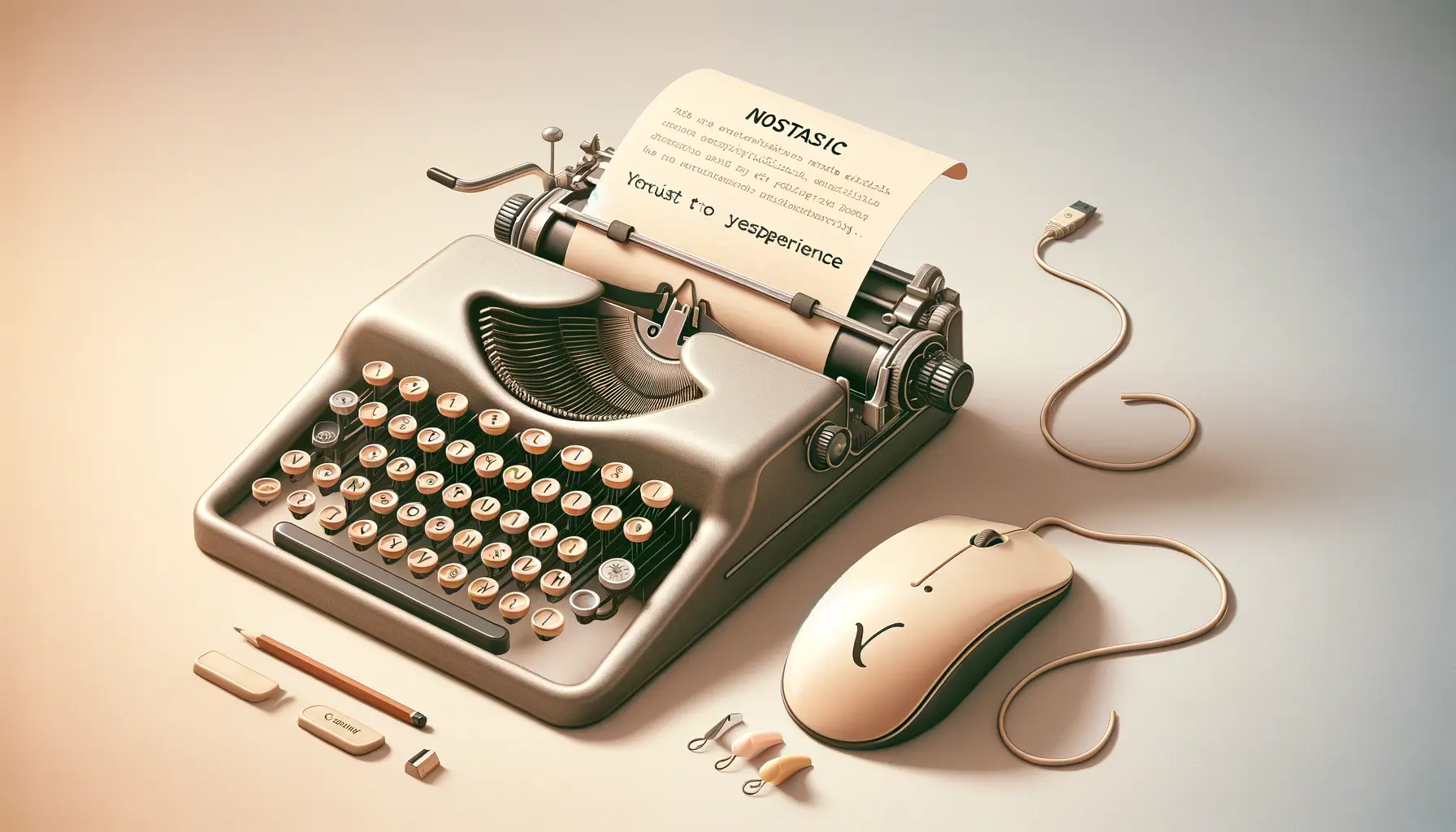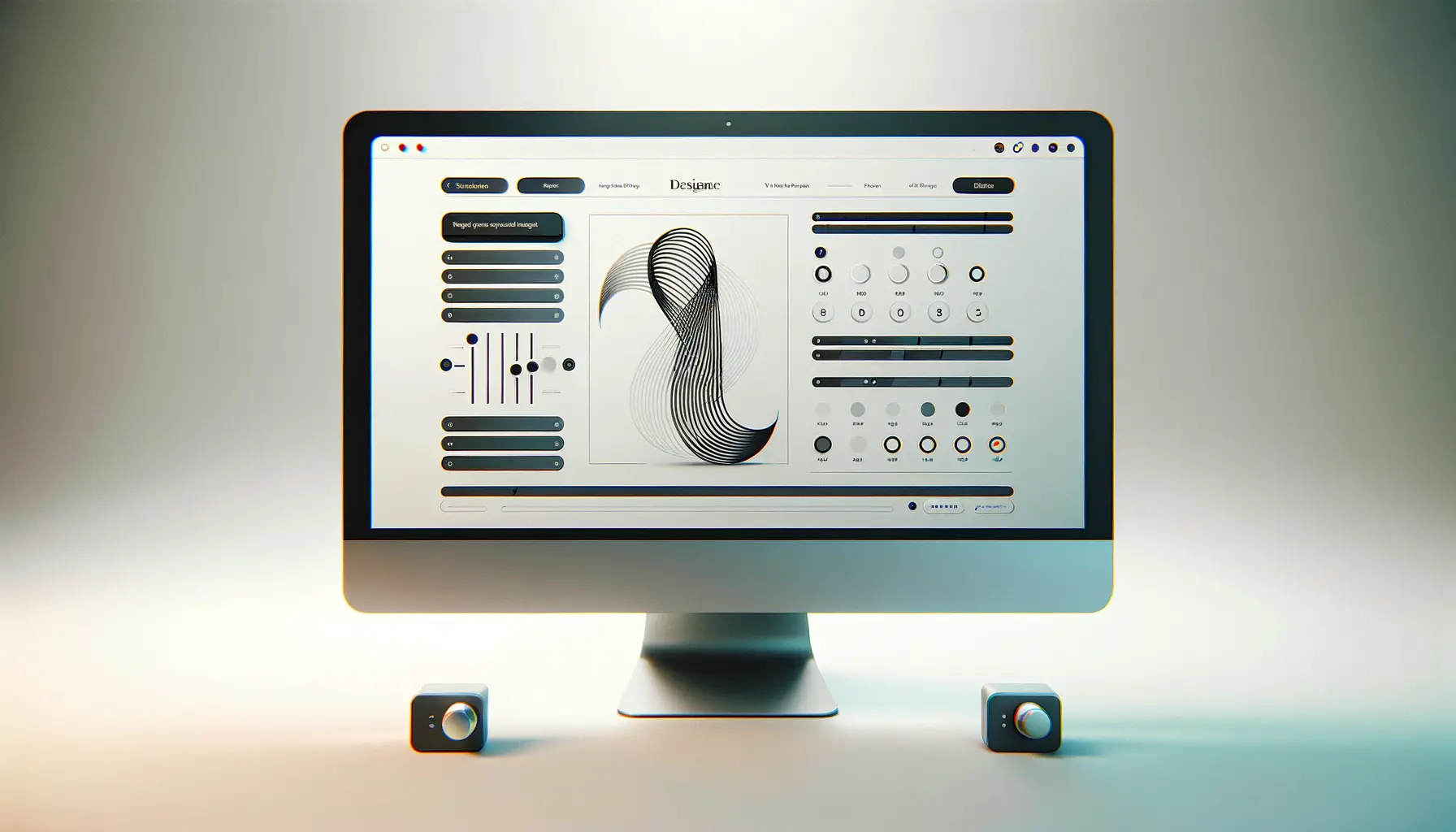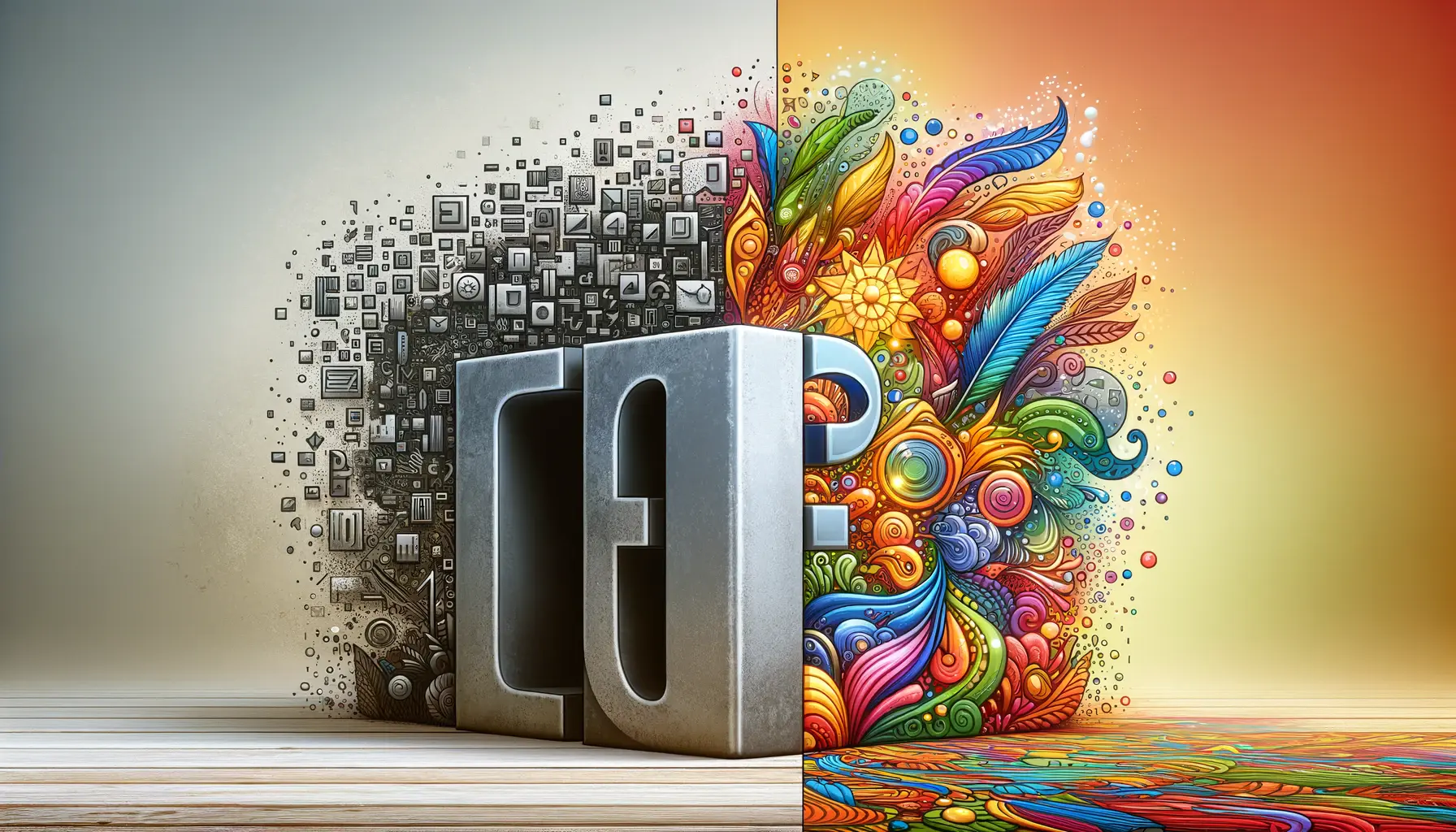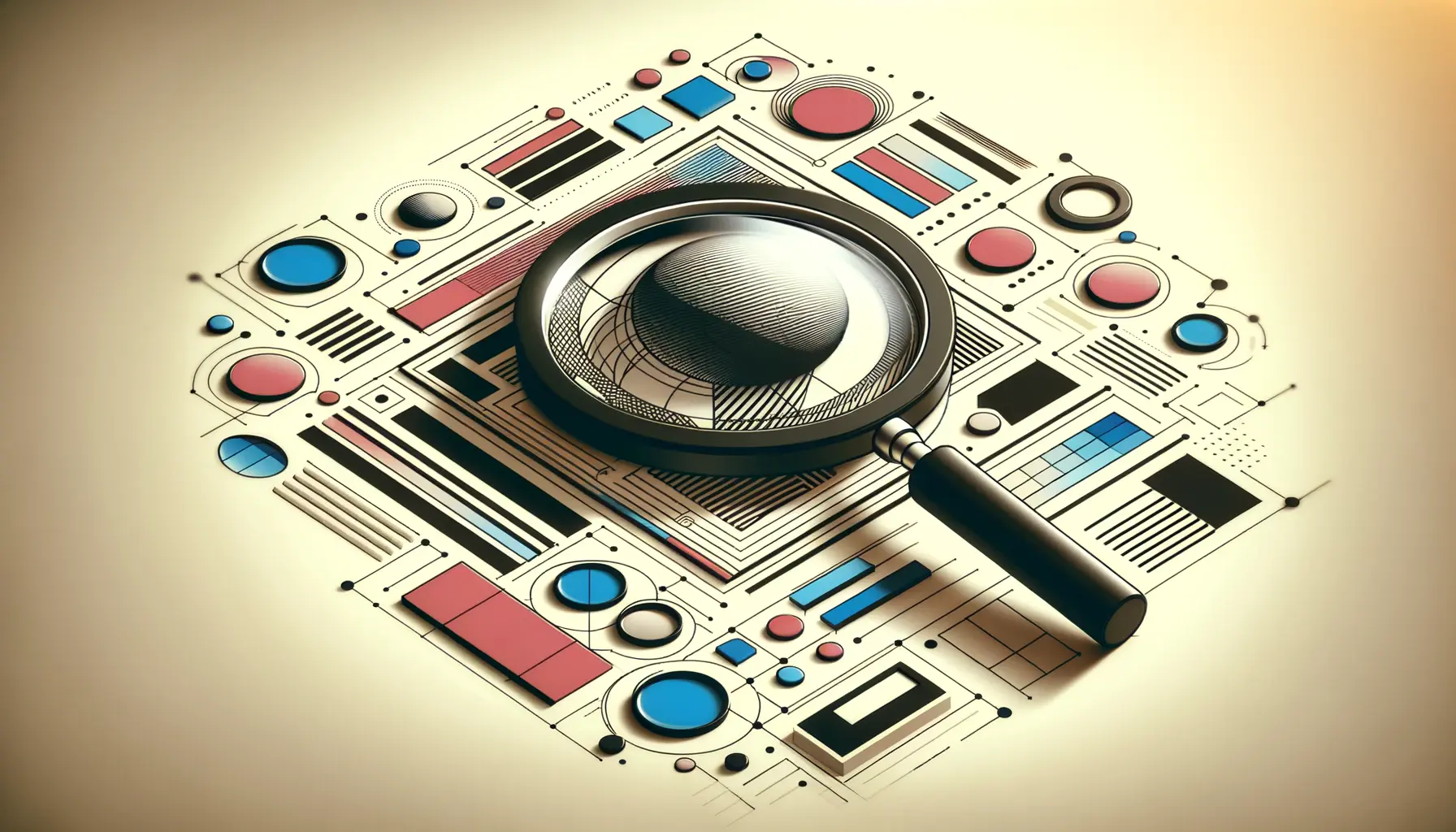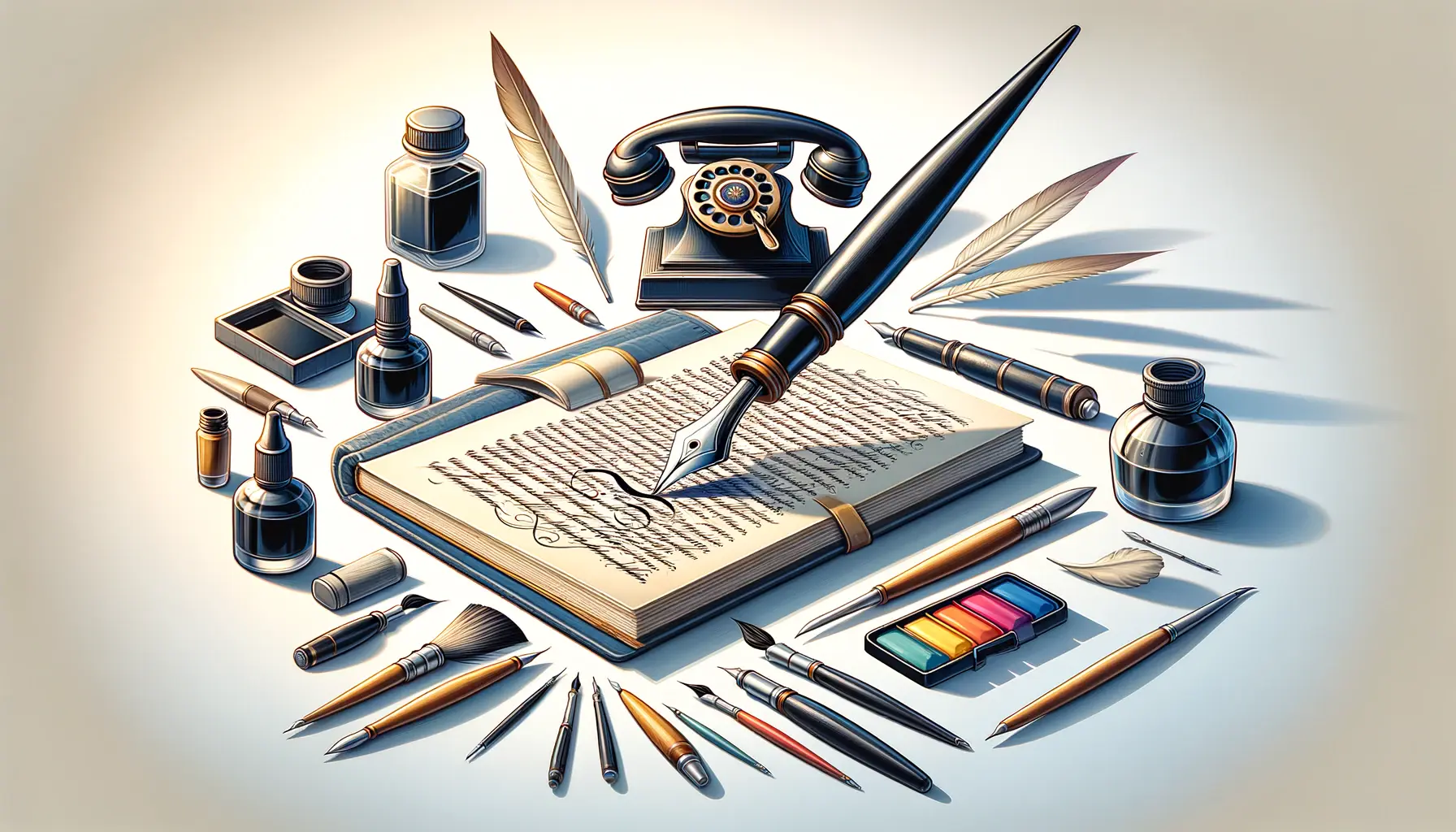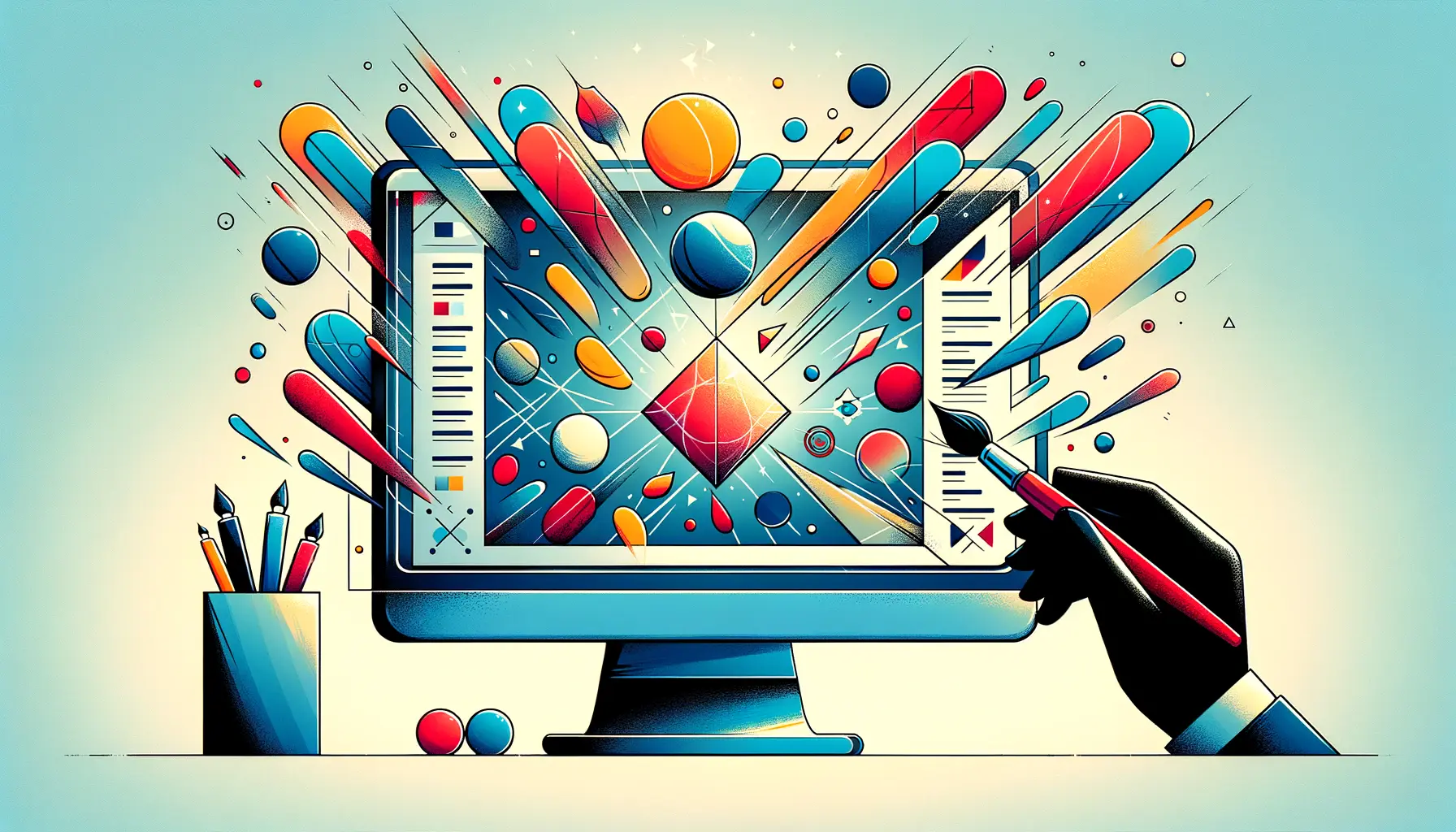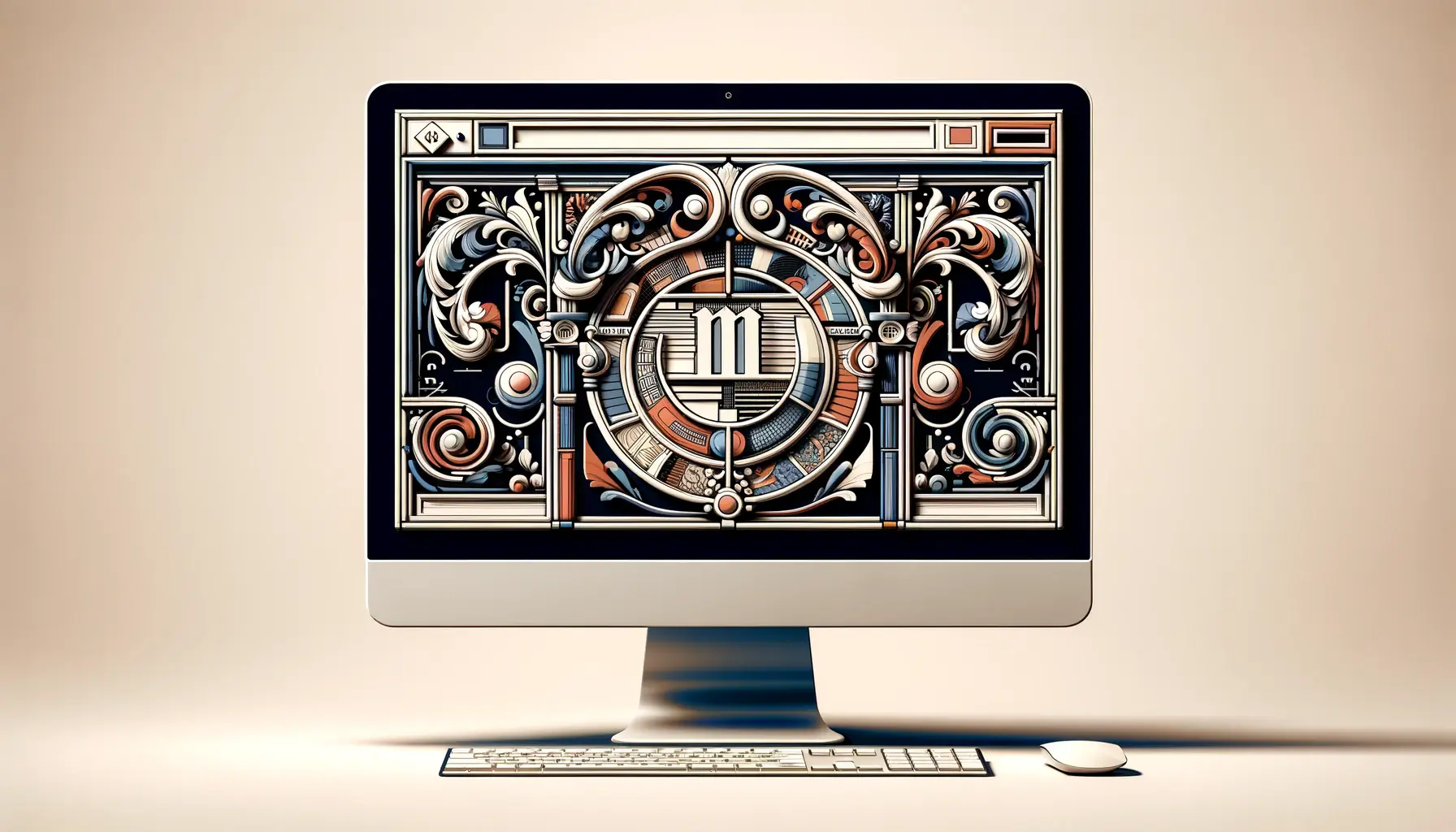In the realm of design, the power of nostalgia cannot be overstated, especially when it comes to typography.
Nostalgic fonts, those that evoke a sense of the past and trigger memories of yesteryears, have a profound impact on user experience.
This influence extends beyond mere aesthetics, touching on emotions, usability, and brand perception.
As we delve into the intricate relationship between nostalgic fonts and user experience, it becomes clear that these typographic choices do more than just decorate a page; they connect with users on a deeply personal level, enhancing engagement and fostering a sense of familiarity and trust.
The resurgence of nostalgic fonts in modern design is not merely a trend but a strategic approach to creating more meaningful and engaging user experiences.
By leveraging the emotional resonance of retro-inspired typography, designers can craft experiences that stand out in the digital landscape.
This article explores the multifaceted impact of nostalgic fonts on user experience, from their psychological effects to their role in branding and digital design.
Through a detailed examination, we uncover the reasons behind their enduring popularity and how they can be effectively utilized to captivate and connect with audiences.
- Understanding Nostalgic Fonts and Their Appeal
- The Role of Nostalgic Fonts in Branding
- Impact on User Experience and Engagement
- Navigating the Challenges of Using Nostalgic Fonts
- Incorporating Nostalgic Fonts into Web Design
- Case Studies: Nostalgic Fonts in Action
- Future Trends in Nostalgic Font Usage
- Embracing the Past to Enhance the Future: The Enduring Impact of Nostalgic Fonts on User Experience
- Nostalgic Fonts and User Experience FAQs
Understanding Nostalgic Fonts and Their Appeal
Defining Nostalgic Fonts
Nostalgic fonts are typefaces that evoke a sense of nostalgia, recalling design styles from previous decades.
These fonts are often associated with specific time periods, such as the bold and groovy lettering of the 70s or the pixelated styles reminiscent of early digital age in the 80s and 90s.
By incorporating these fonts into modern design, creators can invoke the emotions and memories tied to those eras, creating a bridge between the past and present.
The appeal of nostalgic fonts lies in their ability to transport users to a different time, offering a break from the uniformity of contemporary design.
This emotional connection can enhance user engagement, making content more memorable and impactful.
When users encounter a nostalgic font, it can trigger a sense of warmth and familiarity, making the overall experience more personal and relatable.
Psychological Impact of Nostalgia in Design
Nostalgia, a sentimental longing for the past, has a powerful psychological impact.
It can evoke positive emotions, reduce loneliness, and increase social connectedness.
In the context of design, nostalgic fonts can leverage these effects to create a more engaging and emotionally resonant user experience.
By reminding users of the past, these fonts can evoke a sense of comfort and nostalgia, making digital spaces feel more human and less sterile.
Moreover, the use of nostalgic fonts can enhance brand perception by associating products or services with positive memories and emotions.
This emotional branding strategy can lead to stronger customer loyalty and a more distinct brand identity.
For instance, a brand that uses a font reminiscent of the 80s might appeal to consumers who harbor fond memories of that era, creating an instant emotional connection.
Incorporating nostalgic fonts into design projects requires a delicate balance. While they can significantly enhance user experience and emotional engagement, it’s crucial to ensure that they also align with the brand’s identity and the project’s overall aesthetic. The key is to use nostalgic fonts in a way that feels authentic and enhances the message rather than overshadowing it.
The Role of Nostalgic Fonts in Branding
The strategic use of nostalgic fonts in branding is not just about aesthetics; it’s a powerful tool for storytelling and creating a memorable brand identity.
These fonts can convey values, evoke emotions, and establish a connection with the target audience.
Here, we explore how nostalgic fonts play a pivotal role in branding efforts, from evoking brand personality to enhancing brand recall.
Conveying Brand Personality
Nostalgic fonts are instrumental in conveying a brand’s personality.
Depending on the era they represent, these fonts can communicate various traits such as sophistication, whimsy, reliability, or innovation.
For example:
- A brand aiming for a classic, timeless appeal might choose a font with Art Deco influences from the 1920s.
- A company wanting to project fun and energy might opt for bold, colorful fonts reminiscent of the 1980s.
This alignment of font choice with brand personality helps in creating a cohesive brand image that resonates with the target audience.
Enhancing Brand Recall
Utilizing nostalgic fonts can significantly enhance brand recall.
The unique and emotive qualities of these fonts make them stand out in a sea of modern designs, making the brand more memorable to consumers.
When a font evokes a specific time period or feeling, it becomes easier for consumers to recall the brand associated with that nostalgia.
For instance, a brand that uses a typewriter-style font might be remembered for its vintage or artisanal qualities.
This association helps the brand to stick in the minds of consumers, potentially leading to higher recall and recognition.
Building Emotional Connections
One of the most powerful aspects of using nostalgic fonts in branding is the ability to build emotional connections with the audience.
These fonts can:
- Stir up personal memories and emotions, making the brand feel more relatable and human.
- Create a sense of nostalgia that transcends mere visual appeal, engaging users on a deeper emotional level.
This emotional engagement is crucial for building brand loyalty and fostering a strong, lasting relationship with consumers.
In the competitive landscape of digital branding, nostalgic fonts offer a unique way to stand out and connect with audiences on an emotional level. By carefully selecting fonts that align with their brand identity and values, companies can leverage nostalgia to create a distinctive and memorable brand experience.
Impact on User Experience and Engagement
Nostalgic fonts do more than just decorate a webpage; they significantly impact user experience and engagement.
By evoking emotions and memories, these fonts can transform a digital interface into a more engaging and immersive environment.
This section delves into how nostalgic fonts influence user behavior, enhance usability, and ultimately, drive engagement.
The choice of font in a user interface can affect readability, mood, and the user’s overall impression of a website or application.
Nostalgic fonts, in particular, have the unique ability to transport users to a different time, offering a distinct and memorable user experience.
This emotional resonance can lead to increased user engagement, as users are more likely to interact with content that feels personal and evocative.
Enhancing Usability Through Familiarity
One of the key ways nostalgic fonts impact user experience is through the principle of familiarity.
Users are drawn to what they know, and a font that recalls a familiar era can make a digital space feel more welcoming and intuitive.
For example:
- Using a font reminiscent of old newspapers can make a news website feel more authoritative and trustworthy.
- A gaming app that employs pixelated fonts similar to those from vintage video games can enhance the gaming experience by making it feel more authentic.
This familiarity not only improves usability by making users feel at home but also reinforces the content’s theme or purpose, creating a cohesive user experience.
Driving Emotional Engagement
Emotional engagement is crucial for keeping users interested and invested in your content.
Nostalgic fonts can evoke a wide range of emotions, from the warmth of childhood memories to the excitement of retro adventures.
This emotional pull can significantly increase user engagement, as users are more likely to spend time on a site that resonates with them on an emotional level.
Moreover, the emotional impact of nostalgic fonts can lead to higher conversion rates.
Users who feel a strong emotional connection to a brand are more likely to take desired actions, such as making a purchase or signing up for a newsletter.
Improving Content Discoverability
Nostalgic fonts can also play a role in content discoverability.
By using distinctive fonts for headings, subheadings, and call-to-action buttons, designers can guide users’ attention to key areas of a page.
This not only makes the content more accessible but also enhances the overall navigability of the site.
For instance:
- A bold, vintage-style font for headings can draw attention to important sections, improving the flow of information.
- Decorative, nostalgic fonts for call-to-action buttons can make them stand out, increasing the likelihood of user interaction.
While nostalgic fonts can greatly enhance user experience and engagement, it’s important to balance their use with readability and functionality. Overusing these fonts or choosing styles that are difficult to read can detract from the user experience, highlighting the need for a strategic approach to typography in design.
Navigating the Challenges of Using Nostalgic Fonts
While the use of nostalgic fonts in design can offer numerous benefits, it also presents unique challenges.
These challenges range from ensuring readability and accessibility to maintaining a balance between nostalgia and modernity.
Addressing these issues is crucial for leveraging the full potential of nostalgic fonts without compromising the user experience.
Readability and legibility are paramount in any design project, and nostalgic fonts, with their distinct styles and embellishments, can sometimes hinder these aspects.
Designers must carefully select fonts that not only evoke the desired sense of nostalgia but are also easy to read and understand.
This section explores the challenges of using nostalgic fonts and offers strategies for overcoming them.
Ensuring Readability and Accessibility
The intricate details and unique characteristics of nostalgic fonts can sometimes make text difficult to read, especially for users with visual impairments.
To ensure that the use of nostalgic fonts does not compromise readability and accessibility, consider the following strategies:
- Limit the use of highly decorative fonts to headings or short pieces of text.
- Pair nostalgic fonts with more legible, sans-serif fonts for body text to ensure that the content is accessible to all users.
- Adjust font size, spacing, and contrast to enhance legibility and comply with accessibility standards.
Maintaining a Balance Between Nostalgia and Modernity
Finding the right balance between evoking nostalgia and appealing to contemporary tastes is another challenge designers face.
To achieve this balance:
- Combine nostalgic fonts with modern design elements, such as minimalist layouts and contemporary color schemes, to create a harmonious blend of old and new.
- Use nostalgic fonts selectively to accentuate certain aspects of the design without overwhelming the user with too much retro styling.
This approach ensures that the design remains relevant and appealing to today’s audience while still harnessing the emotional power of nostalgia.
Adapting Nostalgic Fonts for Digital Platforms
Many nostalgic fonts were originally designed for print and may not translate well to digital screens.
To adapt these fonts for digital use:
- Opt for digital-optimized versions of nostalgic fonts that have been adjusted for screen readability.
- Test the fonts across different devices and screen resolutions to ensure consistent rendering and legibility.
By addressing these challenges, designers can effectively incorporate nostalgic fonts into their projects, enhancing the user experience without sacrificing functionality or accessibility.
The successful integration of nostalgic fonts into design projects requires a thoughtful approach that considers readability, balance, and digital adaptation. By navigating these challenges effectively, designers can create compelling, emotionally resonant experiences that captivate and engage users.
Incorporating Nostalgic Fonts into Web Design
Integrating nostalgic fonts into web design requires a thoughtful approach that respects the balance between form and function.
The goal is to evoke the desired emotional response from the audience while ensuring the website remains user-friendly and accessible.
This part of the article explores practical tips and considerations for effectively incorporating nostalgic fonts into web design projects.
Choosing the right nostalgic font is just the beginning.
Designers must also consider how these fonts interact with other design elements, such as color schemes, imagery, and layout, to create a cohesive and engaging user experience.
Here are strategies for successfully incorporating nostalgic fonts into web design:
Selecting the Right Font for Your Project
The choice of font should align with the overall theme and message of the website.
Consider the era or mood you wish to evoke and select a font that accurately represents it.
For instance:
- If the website has a vintage theme, a font with Art Nouveau influences might be appropriate.
- For a project that aims to evoke a sense of 80s nostalgia, a geometric sans-serif font reminiscent of that decade could be ideal.
It’s also important to consider the font’s readability and how it will be used throughout the site to ensure a consistent and cohesive design.
Combining Fonts Effectively
Pairing nostalgic fonts with more contemporary fonts can create a dynamic and visually interesting design.
However, it’s crucial to maintain harmony and readability.
A few tips for combining fonts effectively include:
- Limit the number of font families used to avoid visual clutter.
- Ensure there is enough contrast between the fonts chosen for headings and body text.
- Use font pairing tools or consult typographic resources to find complementary fonts.
Integrating Fonts with Other Design Elements
Nostalgic fonts should complement and enhance other design elements on the website.
This integration can be achieved by:
- Matching the color palette to the era the font represents, using hues that were popular at the time.
- Incorporating imagery, textures, or patterns that reinforce the nostalgic theme.
- Adapting the layout and navigation to reflect the design sensibilities of the period, without sacrificing usability.
This holistic approach ensures that the nostalgic fonts not only stand out but also contribute to a unified and immersive user experience.
Effectively incorporating nostalgic fonts into web design is an art that involves careful selection, thoughtful pairing, and seamless integration with other design elements. By following these guidelines, designers can create websites that not only look beautiful but also resonate deeply with users, evoking cherished memories and emotions.
Case Studies: Nostalgic Fonts in Action
Examining real-world examples can provide valuable insights into the effective use of nostalgic fonts in design.
These case studies highlight how different brands and designers have successfully incorporated nostalgic fonts into their projects, achieving remarkable results in terms of branding, user engagement, and overall design aesthetics.
Through these examples, we can see the diverse applications of nostalgic fonts across various industries and platforms, demonstrating their versatility and impact on user experience.
Reviving a Classic Brand
A well-known beverage company decided to rebrand, aiming to reconnect with its roots and appeal to both long-time fans and a new generation of consumers.
The redesign focused on bringing back a version of the iconic logo that featured a nostalgic font reminiscent of the brand’s early days.
This strategic use of typography helped evoke a sense of heritage and authenticity, leading to a positive reception from the audience and an increase in brand loyalty.
The rebranding effort extended beyond the logo to packaging, marketing materials, and digital platforms, creating a cohesive brand experience that leveraged nostalgia to strengthen the brand’s identity and market position.
Enhancing a Digital Experience
An online platform specializing in vintage goods used nostalgic fonts to create a unique and immersive shopping experience.
By carefully selecting fonts that reflected the eras of the items being sold, the website was able to transport users back in time, making browsing and shopping a more engaging and enjoyable activity.
This approach not only differentiated the platform from competitors but also reinforced the authenticity of the vintage products, leading to increased user engagement and sales.
The thoughtful integration of nostalgic fonts into the web design played a key role in achieving these outcomes.
Creating an Engaging Marketing Campaign
A marketing campaign for a music festival that celebrated retro music genres utilized nostalgic fonts to capture the spirit of the event.
The fonts were used across posters, social media, and the event website to create a consistent and compelling visual identity that resonated with the target audience.
The use of nostalgic fonts helped evoke the excitement and energy of past music eras, contributing to the campaign’s success in attracting attendees and generating buzz around the event.
This case study demonstrates the power of nostalgic fonts in creating an emotional connection and driving engagement through design.
While nostalgic fonts can significantly enhance a project’s appeal, it’s important to remember that their success depends on thoughtful application and integration with the overall design strategy. These case studies exemplify how a well-considered use of nostalgic fonts can lead to meaningful and impactful design solutions.
Future Trends in Nostalgic Font Usage
The landscape of design is ever-evolving, with nostalgic fonts playing a significant role in shaping future trends.
As we look forward, it’s clear that these fonts will continue to influence design in various ways, adapting to new technologies and user expectations while retaining their emotional and aesthetic appeal.
This section explores potential future trends in the use of nostalgic fonts, offering insights into how they might continue to impact design and user experience.
Understanding these trends can help designers stay ahead of the curve, ensuring that their use of nostalgic fonts remains relevant and effective in engaging audiences.
Increased Personalization and Customization
As technology advances, we can expect to see more personalized and customized font experiences.
This could include:
- Fonts that adapt to user preferences or browsing history, offering a more tailored experience.
- Customizable nostalgic fonts that allow users to modify aspects like weight, width, or ornamentation to suit their tastes.
This trend towards personalization will enhance the user experience, making digital spaces more engaging and reflective of individual identities.
Integration with Augmented Reality and Virtual Reality
Nostalgic fonts are poised to play a significant role in augmented reality (AR) and virtual reality (VR) environments.
In these immersive platforms, fonts can:
- Enhance the realism of historical or thematic experiences by accurately representing different time periods.
- Add a layer of emotional depth to virtual environments, making them more compelling and memorable.
This integration will open up new possibilities for storytelling and brand engagement in digital spaces.
Focus on Sustainability and Ethical Design
The growing emphasis on sustainability and ethical design practices will influence the use of nostalgic fonts.
Designers might:
- Opt for fonts that reflect historical periods known for their emphasis on craftsmanship and durability.
- Use nostalgic fonts to evoke a sense of timelessness and longevity in design, aligning with sustainable values.
This trend will encourage more thoughtful and responsible design choices, with nostalgic fonts supporting messages of sustainability and ethical consumption.
Collaboration Between AI and Typography
The collaboration between artificial intelligence (AI) and typography is expected to grow, with AI tools helping to create and refine nostalgic fonts.
This could lead to:
- AI-generated nostalgic fonts that combine elements from various eras to create entirely new typographic styles.
- Improved font rendering and optimization for digital platforms, enhancing the usability and accessibility of nostalgic fonts.
As these trends develop, the role of nostalgic fonts in design will undoubtedly expand, offering new opportunities for creativity and engagement.
By staying attuned to these future directions, designers can continue to leverage the power of nostalgia in innovative and meaningful ways.
The future of nostalgic font usage in design is bright, with advancements in technology and shifts in cultural values opening up new avenues for creativity and engagement. As designers, embracing these trends and exploring the possibilities they offer will be key to creating resonant and impactful designs that stand the test of time.
Embracing the Past to Enhance the Future: The Enduring Impact of Nostalgic Fonts on User Experience
The journey through the world of nostalgic fonts reveals their profound impact on design, branding, and user experience.
As we’ve explored, these fonts do more than merely adorn a page or project; they evoke emotions, connect with audiences on a personal level, and significantly influence user engagement and brand perception.
The strategic use of nostalgic fonts in design not only pays homage to the past but also sets the stage for future innovations in typography and user experience design.
The Timeless Appeal of Nostalgia in Design
Nostalgic fonts carry the unique ability to bridge generations, connecting the past with the present in a harmonious dance of design elements.
Their appeal lies in their versatility and emotional resonance, making them a powerful tool in the hands of designers.
By carefully selecting and integrating nostalgic fonts into projects, designers can create experiences that are both visually stunning and emotionally engaging, fostering a deeper connection with the audience.
Strategies for Success with Nostalgic Fonts
To maximize the impact of nostalgic fonts on user experience, designers should consider several key strategies:
- Balance nostalgia with modernity to ensure designs remain relevant and appealing to contemporary audiences.
- Ensure readability and accessibility to make nostalgic designs inclusive and user-friendly.
- Integrate fonts with other design elements for a cohesive and immersive experience.
These strategies underscore the importance of thoughtful design choices and highlight the potential of nostalgic fonts to enrich the user experience.
Looking Ahead: The Future of Nostalgic Fonts in Design
The future of nostalgic fonts in design is bright, with emerging trends indicating a continued fascination with the past, coupled with a desire for innovation and personalization.
As technology evolves, so too will the ways in which nostalgic fonts are used, offering new opportunities for creating meaningful and memorable user experiences.
The integration of nostalgic fonts with advanced technologies like AR, VR, and AI promises to open new frontiers in design, where the past and future converge in exciting and unexpected ways.
In conclusion, the impact of nostalgic fonts on user experience is undeniable.
These fonts offer a unique blend of emotional resonance and visual appeal, making them an invaluable asset in the design toolkit.
As we move forward, the thoughtful integration of nostalgic fonts will continue to play a crucial role in shaping the future of design, branding, and user engagement.
By embracing the past, designers can enhance the future, creating experiences that resonate deeply with users and stand the test of time.
Quality web design is key for a great website! Check out our service page to partner with an expert web design agency.
Nostalgic Fonts and User Experience FAQs
Explore common inquiries about the impact of nostalgic fonts on user experience, offering insights into how these timeless typefaces shape digital landscapes.
Nostalgic fonts can significantly boost user engagement by evoking positive emotions and memories, making digital experiences more relatable and memorable.
Yes, by evoking a sense of authenticity and heritage, nostalgic fonts can enhance brand perception and foster a deeper emotional connection with the audience.
Challenges include ensuring readability and accessibility, balancing nostalgia with modern design elements, and adapting fonts for digital platforms.
While versatile, nostalgic fonts must be chosen carefully to align with a website’s theme and audience, ensuring they enhance rather than detract from the user experience.
Designers can combine fonts by ensuring visual harmony and contrast, using nostalgic fonts for headings or accents, and modern fonts for body text.
Nostalgic fonts are key in emotional design, leveraging past associations to evoke specific feelings and enhance the overall emotional impact of a design.
While they add character, nostalgic fonts must be used judiciously to maintain readability and accessibility, especially for users with visual impairments.
Future trends include increased personalization, integration with AR and VR, a focus on sustainability, and the collaboration between AI and typography.
